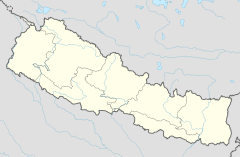Muktinath
| Muktinath Temple | |
|---|---|
Muktinath (Dhawalagiri) | |
| Country | Nepal |
Location in Nepal | |
| Geographic coordinates | 28°49′01″N 83°52′18″E / 28.816854°N 83.871742°E |
| Architecture | |
| Type | Pagoda |
| Elevation | 3,762 m (12,343 ft) |
Muktinath is an ancient
For Buddhists, Muktinath is an abode of
Muktinath temple is seen as a symbol of religious harmony in Nepal where both the Hindus and Buddhists have been historically worshipping on the same spot, mutually respecting and including each other.[6]
Legend
Muktinath's importance within Hinduism is described in ancient Hindu
Architecture
The central shrine of Muktinath is considered by Hindu
Religious significance
Hinduism

Muktinath is sacred to the

Shaktism
Muktinath Temple is considered an important place of pilgrimage in
Muktinath temple complex is also revered as a place on earth to host all five elements (fire, water, sky, earth, and air) from which all material things in the universe are made. The goddess Jwala Mai Temple situated adjacent to the Muktinath Temple is worshipped for its sacred flame fueled by natural gas emanating from the earth.[12]
Buddhism

The temple has been worshipped by Buddhists as an abode of Avalokiteśvara, the Buddha who embodies the compassion of all Buddhas. In Tibetan Buddhism, the place is known as "Chumig Gyatsa" (the Hundred Springs) and is venerated as one of the important places related to Padmasambhava, the founder of Tibetan Buddhism and one of the 24 Tantric (sacred) places of Tibetan Buddhism. [2] The area of the temple is worshipped as a residence of 21 Tara and many Dakinis, goddesses known as Sky Dancers.[13] [2]
-
Statue of Guru Padmasambhava
-
Buddhist Goddess in Muktinath temple complex
-
Buddhist thangka
The nuns of the temple complex are considered to be female goddesses called Dakinis and to be the offsprings of the females who were taught by Padmasambhava during his stay in Muktinath. It is believed that Padmasambhava built a statue in his own image before departing from Muktinath to Tibet, which resides in the Mharme Lhakhang Gompa and is tended by these nuns.[13]
Gallery
-
Muktinath valley
-
Muktinath Temple
-
Entrance to the temple area
-
Inside Muktinath Temple
-
Goddess Jwala Mai Temple
-
Muktinath Temple with 2 ponds (right) and 108 spouts (left)
-
Close-up of one of the 108 holy spouts
-
Pilgrims in Muktinath
-
Temple and pond
-
Prayer flags over Muktinath area
-
Gumba
-
Buddha overlooking valley
See also
- Narsingh Gompa, a buddhist monastery nearby
- Bajrayogini Temple
- Guhyeshwari Temple
- Pashupatinath temple, Nepal
- Badrinath
- Kedarnath
- Manasarovar
- Changu Narayan
- Janaki Mandir
- Shree Pashupatinath
- Budhanilkantha Temple, Sleeping Vishnu
References
- ^ a b "Nepal's Top Pilgrimage and Holy Sites – The Abode of Spirituality". Nepali Sansar. 2019-03-30. Retrieved 2020-12-14.]
- ^ a b c d "Brief history of Muktinath-Chumig Gyatsa at the Annapurna Circuit - Nepal". muktinath.org. Retrieved 2024-06-28.
- ^ "Muktinath Temple". templesofindia.co. 2024-04-13. Retrieved 2024-06-28.
- ^ Alightindia. "Muktinath Temple - History, information & Temple timings". Muktinath Temple - History, information & Temple timings. Retrieved 2024-06-28.
- ^ Zurick, David (2006). Illustrated Atlas of the Himalayas. Lexington: University Press of Kentucky. p. 153.
- ^ a b "Brief history of Muktinath-Chumig Gyatsa at the Annapurna Circuit - Nepal". muktinath.org. Retrieved 2024-06-28.
- ^ "Gandaki Chandi Homam | Devi Homam |". www.vedicfolks.com. Retrieved 2024-06-29.
- ^ Alightindia. "Muktinath Temple - History, information & Temple timings". Muktinath Temple - History, information & Temple timings. Retrieved 2024-06-28.
- ^ a b "History of Muktianth Temple". Muktinath Temple Tour | Muktinath Temple Package | Muktinath Yatra. Retrieved 2024-06-30.
- ^ "Muktinath Temple: Muktinath Dham History, Muktinath Mandir Dharshan 2022". Divine Kailash. Retrieved 2024-06-30.
- ^ a b R., Dr. Vijayalakshmy (2001). An introduction to religion and Philosophy - Tévarám and Tivviyappirapantam (1st ed.). Chennai: International Institute of Tamil Studies. pp. 489–90.
- ^ Tour, Pilgrimage (2024-01-08). "Places to Visit In and Around Muktinath". Medium. Retrieved 2024-06-30.
- ^ a b "Muktinath: An Exemplar of Religious Symbiosis | Buddhistdoor". www2.buddhistdoor.net. Retrieved 2024-06-30.
Picture in map of nepal


















